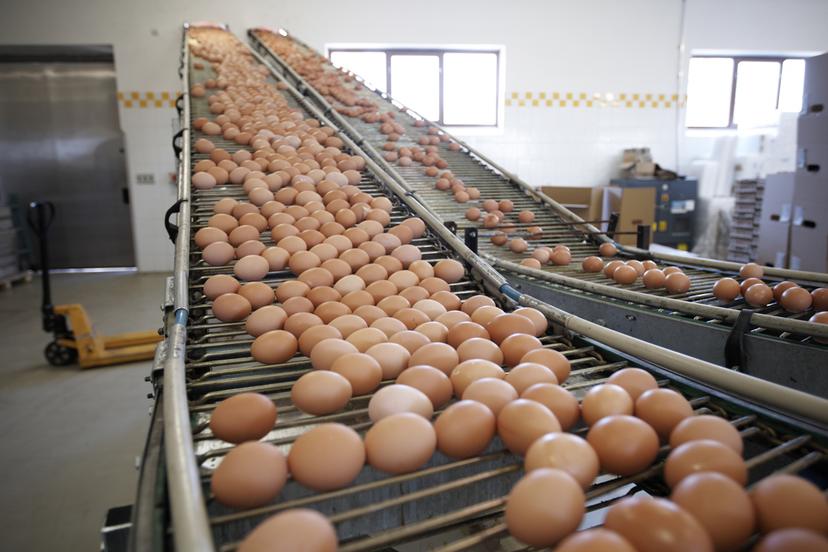Food and Beverage Production

Background
Before the Industrial Revolution, there were relatively few commercially processed and packaged food and nonalcoholic beverage products. People bought their foods mostly in bulk out of barrels, bins, sacks, and jugs. These bulk products were sold in small stores; the supermarket did not exist. An important development in food preservation and processing was the canning process, first developed by the Parisian chef Nicolas Appert in 1810. He found that heating foods sealed in bottles or cans killed the bacteria that spoil food and removed oxygen, which allows foods to break down. Canning allowed foods to remain unspoiled for longer periods, and cans were also easy to transport. Pasteurization, developed by French chemist Louis Pasteur, made bottled milk and other beverages safer. Pasteur’s scientific explanation and understanding of the fermentation process made large-scale beer brewing and wine making possible.
As urban centers grew, so did the need for food and beverages that could be shipped easily. The Industrial Revolution had two major impacts on the food and beverage industry. The first was that new mechanical systems allowed the development of inexpensive production of canned, bottled, and processed goods. The second was that wages increased in the cities and people could afford to spend more money on food and beverages. People shifted from a diet of predominantly breads and grains to one that included meats, vegetables, and dairy products. Soon, consumer demand led manufacturers to develop an ever-increasing variety of foods and beverages.
In the 1920s, new refrigeration techniques allowed for the freezing of foods, a process that kept both flavor and nutritional value intact. Manufacturing processes, including the development of assembly line production methods, enabled companies to produce larger quantities of many different kinds of foods and beverages and to provide the consumer with a wider variety of products that were easy to prepare and easy to store in refrigerators, freezers, or on cupboard shelves.
The early part of the 20th century, especially after World War I, saw a huge growth in the U.S. food and beverage industry. Manufacturers developed new and improved processing methods and varieties of new products. They also developed containers and packages for suitable and safe handling of these products. The science of food and beverage technology became especially important around 1940, as the United States prepared to enter World War II. New methods of processing, preparing, packaging, and transporting food and beverages were needed to supply the troops as they went into battle. A variety of chemical preservation methods were developed, which led to the Food Additive Amendment of 1958, to control the type and amount of chemical preservatives that could be added to foods and beverages.
The 20th century also saw a major change in the ways people purchased food and beverages, especially nonalcoholic beverages. Prior to World War I, consumers were most likely to buy their food at small neighborhood stores. But the introduction of trucks and automobiles not only made people more mobile but also allowed foods, beverages, and other products to be more easily transported.
The first supermarkets began to appear, offering a greater selection of goods and combining many small shops under one roof: a fruit and vegetable stand, a meat market, a dry goods store. Chains of stores were able to lower their costs by purchasing and marketing together so they could afford to sell foods with lower profit margins than the smaller shops. Supermarkets made money because selling more products offset the lower profit they made on each item. By the 1950s, most Americans bought their food and nonalcoholic beverages, such as milk and soft drinks, in supermarkets instead of small groceries and specialty shops, and going to the supermarket became an American way of life.
Early supermarkets were still quite small compared to the supermarkets of today. U.S. consumers now select groceries from an assortment of some 10,000 to 12,000 items, as opposed to a limited selection of only about 1,000 items available in the 1950s. Two-thirds of today’s grocery store items are new or have been improved materially within the past few decades. Today’s household includes many timesavers that have lightened food preparation chores. Frozen dinners, frozen bread dough, dehydrated foods, bottled teas and other soft drinks, and other products provide millions of people with their meals. A growing segment of the marketplace is home meal replacement. These are prepared items, including entrees and side dishes, that are cooked and ready-to-eat, or that require only warming. They are not frozen but kept in the deli or other refrigerated section of the store.
Developments in foods, beverages, and their technologies continue today. Methods such as nitrogen flushing, which replaces oxygen in packages with nitrogen to retard spoiling, and irradiation, which involves exposing foods to low levels of radiation to reduce or remove completely the microorganisms that might spoil the food or pose a danger to human health, have been developed. Irradiation is now used on a variety of foods and in many countries across the world. Foods, such as tomatoes, can be more quickly ripened using chemicals, gases, and other processes. Food scientists have long worked with genetic manipulation, creating such foods as seedless grapes and oranges and “burpless” cucumbers; more recently, scientists have developed methods of introducing new genes into fruits, vegetable, and animals to change various properties, such as color, flavor, and shelf life.
The emphasis on a healthier style of eating has resulted in the development, production, and wide distribution of low-fat and nonfat food items. Beverages are made with calorie-free artificial sweeteners. Ironically, just as food labs are discovering ways to chemically alter foods or beverages to reduce or eliminate the fat or sugar content, an increasing section of the market is demanding organic, or completely naturally grown, produce. Specialty supermarkets devoted to the sale of organic foods are opening in greater numbers across the country. As the market for organic, all-natural produce grows, a corresponding rise will occur in the processed foods made from such organic produce.
